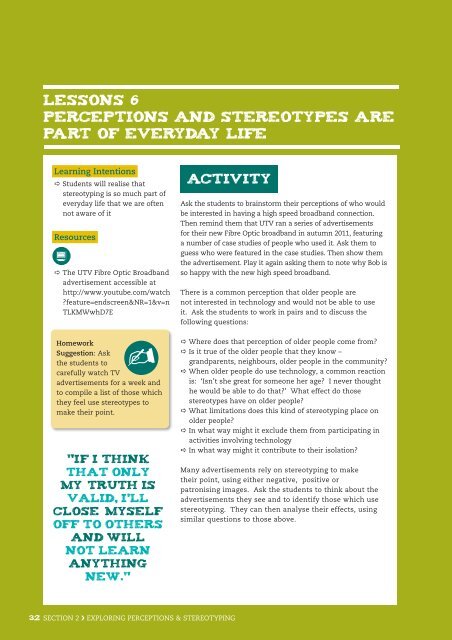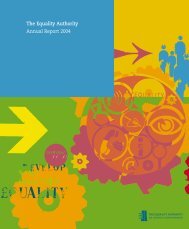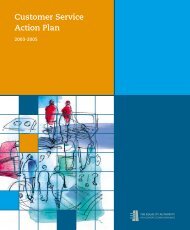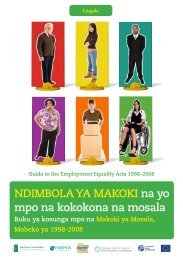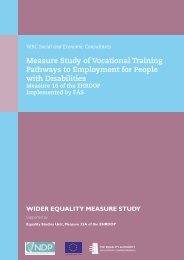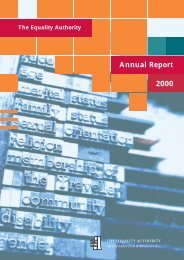Equality and Diversity - Building a Culture of ... - Equality Authority
Equality and Diversity - Building a Culture of ... - Equality Authority
Equality and Diversity - Building a Culture of ... - Equality Authority
You also want an ePaper? Increase the reach of your titles
YUMPU automatically turns print PDFs into web optimized ePapers that Google loves.
Lessons 6<br />
Perceptions <strong>and</strong> Stereotypes are<br />
Part <strong>of</strong> everyday Life<br />
Learning Intentions<br />
Students will realise that<br />
stereotyping is so much part <strong>of</strong><br />
everyday life that we are <strong>of</strong>ten<br />
not aware <strong>of</strong> it<br />
Resources<br />
<br />
The UTV Fibre Optic Broadb<strong>and</strong><br />
advertisement accessible at<br />
http://www.youtube.com/watch<br />
?feature=endscreen&NR=1&v=n<br />
TLKMWwhD7E<br />
Homework<br />
Suggestion: Ask<br />
the students to<br />
carefully watch TV<br />
advertisements for a week <strong>and</strong><br />
to compile a list <strong>of</strong> those which<br />
they feel use stereotypes to<br />
make their point.<br />
<br />
"If I think<br />
that only<br />
my truth is<br />
valid, I’ll<br />
close myself<br />
<strong>of</strong>f to others<br />
<strong>and</strong> will<br />
not learn<br />
anything<br />
new."<br />
Activity<br />
Ask the students to brainstorm their perceptions <strong>of</strong> who would<br />
be interested in having a high speed broadb<strong>and</strong> connection.<br />
Then remind them that UTV ran a series <strong>of</strong> advertisements<br />
for their new Fibre Optic broadb<strong>and</strong> in autumn 2011, featuring<br />
a number <strong>of</strong> case studies <strong>of</strong> people who used it. Ask them to<br />
guess who were featured in the case studies. Then show them<br />
the advertisement. Play it again asking them to note why Bob is<br />
so happy with the new high speed broadb<strong>and</strong>.<br />
There is a common perception that older people are<br />
not interested in technology <strong>and</strong> would not be able to use<br />
it. Ask the students to work in pairs <strong>and</strong> to discuss the<br />
following questions:<br />
Where does that perception <strong>of</strong> older people come from?<br />
Is it true <strong>of</strong> the older people that they know –<br />
gr<strong>and</strong>parents, neighbours, older people in the community?<br />
When older people do use technology, a common reaction<br />
is: ‘Isn’t she great for someone her age? I never thought<br />
he would be able to do that?’ What effect do those<br />
stereotypes have on older people?<br />
What limitations does this kind <strong>of</strong> stereotyping place on<br />
older people?<br />
In what way might it exclude them from participating in<br />
activities involving technology<br />
In what way might it contribute to their isolation?<br />
Many advertisements rely on stereotyping to make<br />
their point, using either negative, positive or<br />
patronising images. Ask the students to think about the<br />
advertisements they see <strong>and</strong> to identify those which use<br />
stereotyping. They can then analyse their effects, using<br />
similar questions to those above.<br />
32 SECTION 2 EXPLORING PERCEPTIONS & STEREOTYPING


